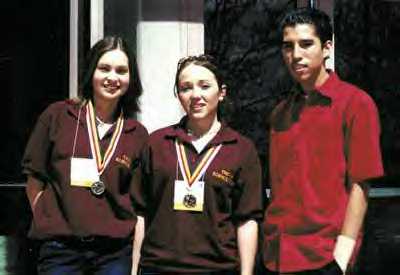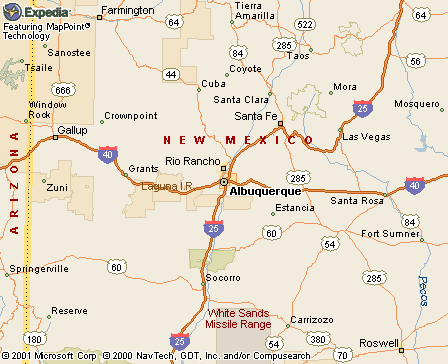|
|
Canku Ota |
|
|
(Many Paths) |
||
|
An Online Newsletter Celebrating Native America |
||
|
May 1, 2004 - Issue 112 |
||
|
|
||
|
Native Science and Engineering Fair |
||
|
by Brenda Norrell / Southwest
Staff Reporter / Indian Country
Today
|
||
|
credits: Young
"Einsteins" Shelley Davis, Jenna Parisien and Daniel Concho
participated in the science and engineering fair in Albuquerque,
N.M. (Brenda Norrell / Indian Country Today)
|
|
"This project has helped me decide what I want to do with my life," said Bill, junior at Fort Wingate High School in New Mexico. Bill, among five grand prize winners, was among Native students attending the 17th Annual National American Indian Science and Engineering Fair, "Celebrating our Journey, Sharing our Vision," at the Albuquerque Convention Center March 25 - 27. When Bill decided to research the effect of natural remedies for healing, she first chose traditional Diné medicines. "I was researching herbal medicines that Native Americans use. I wanted to use my own traditional medicines, but my grandmother told me I had to get permission from the medicine man, which I have now." Bill, however, proceeded with her science experiment by using common remedies, instead of focusing on ceremonial remedies. "My grandmother suggested I use sage and pinon sap." Bill also added tea tree oil, witch hazel, garlic and aloe for natural remedies. Bill titled her project "Nature’s Pharmacy," and compared the ability of herbal medicines and synthetic pharmaceuticals to kill two infections of the skin, Staphylococcus and E. coli. Bill discovered that tea tree oil was the most effective of the natural and pharmaceutical remedies. "It was more effective than synthetic medicines." Enthusiastic about her research, Bill said she learned more about traditional medicines. Now, she feels strongly that the cure for cancer, HIV and other diseases can be found in nature’s pharmacy. She said only 25 percent of medicines are made from herbs today. Herbal medicines hold a mystery that lures her. "No one knows what the effective ingredients are, that is interesting," she said. Jenna Parisien was presented with the problem of how to send DNA in a less expensive way than in test tubes, which costs hundreds of dollars. While working for a company, which sends DNA for bacteria research, she spent nine months developing and perfecting a method, which is now being patented. Parisien devised a method of putting DNA into an ink cartridge. The DNA is then sent in the form of ink as words in a letter. The cost is only the price of postage to transport. "The DNA is actually in the ink," said Parisien. The high school senior at Turtle Mountain Community High School in North Dakota, captured six awards and about $1,000 in cash. She plans a career as a pediatrician. Daniel Concho, a senior at Barstow High School in Barstow, Calif., wanted to learn more about the effects of rhythm on healing. Concho began his science experiments in grade school with solar energy research on algae and chlorophyll. In ninth grade, he began struggling to find a new topic. While playing the drums one day, he began to wonder what affect the rhythm of drums had on the body. Yeast particles were perfect for the experiment. "They don’t have ears, they don’t have minds, they just have cells. They just do what they do," Concho said. Ultimately, he said, "Drumming has the power to change the world." For his research, he chose yeast cells (Saccharomyces cerivisiae) and two types of drum music. For the rock sounds, he chose Yanni and for the American Indian drummers, he chose the sound of the White Cloud Singers from Barstow. "I found out Native American drumming is healing. It caused the reproductive rates of the yeast cells to slow down, to relax," Concho said. When the yeast cells were exposed to rock music, the cells multiplied faster. Grand prize winner Casey Chatfield, Chickasaw senior at Byng High School in Ada, Okla., prepared to leave for home from Albuquerque with a bag of awards, including the math test award, Intel award, AT&T award and hundreds of dollars in cash awards. Chatfield researched carbon dioxide concentrations in classrooms. "Indoor air quality is a major environmental risk that many people don’t know about." At 1,000 parts per million, carbon dioxide can have an effect. "It can effect concentration, simple tasks and memory." When carbon dioxide levels reach 5,000 parts per million in stuffy, closed up classrooms there is more harmful effects, including headaches and eye irritations. Nathanael Willie of Fort Wingate High School won for his environmentally-conscious experiment. He researched the Exxon oil spill of the coast of Alaska. Curious if E. coli and other bacteria would feed off of the oil elements and help eliminate it, Willie discovered that this was possible. Shelley Davis, Turtle Mountain Chippewa from North Dakota and grand prize alternate, explored the mechanisms of herbicides. "I found out the 2-4D had the most destructive effect on the bacterial count and plant life." The research on this selective herbicide is important, she said, because farmers need to know how to kill weeds without killing crops, house plants or animals. "It is important for them to get rid of weeds and preserve the plant." Grand prize winners will be competing at the Intel International Science and Engineering Fair in Portland, Ore. in May. The grand prize winners were Bill, Willie, Chatfield, Parisien and Jillian Beaufeaus of Cloquet, Minn. The alternates were Davis and Branyon Bullard of St. Paul, Minn. The science and engineering fair was designed to showcase Native students’ scientific talents and projects as well as to prepare American Indian students for college. Students had the opportunity to learn how to present science fair projects, write college admissions essay, complete financial aid applications and identify potential colleges and apply for scholarships. Gomez said the entries were impressive. "These projects are a testament to the strength, expertise and vision possessed by Native youth, families and communities." AISES is a private, non-profit organization that nurtures building of community by bridging science and technology with traditional Native values. The fair, open to students in grades 5 - 12, supports the advancement of mathematics, science and engineering. |
|
|
www.expedia.com |
|
|
||
|
|
||
| Canku Ota is a free Newsletter celebrating Native America, its traditions and accomplishments . We do not provide subscriber or visitor names to anyone. Some articles presented in Canku Ota may contain copyright material. We have received appropriate permissions for republishing any articles. Material appearing here is distributed without profit or monetary gain to those who have expressed an interest. This is in accordance with Title 17 U.S.C. Section 107. | ||
|
Canku Ota is a copyright © 2000, 2001, 2002, 2003, 2004 of Vicki Lockard and Paul Barry. |
||
 |
 |
|
|
The "Canku Ota - A Newsletter Celebrating Native America" web site and its design is the |
||
|
Copyright © 1999, 2000, 2001, 2002, 2003, 2004 of Paul C. Barry. |
||
|
All Rights Reserved. |
||
 ALBUQUERQUE,
N.M. - Jenna Parisien, Turtle Mountain Chippewa, designed a new
method to transport DNA, while Daniel Concho, Acoma Pueblo, proved
the power of the rhythm of Native drums to soothe and heal. Rachelle
Bill, Navajo, found tea tree oil more effective than synthetic
drugs.
ALBUQUERQUE,
N.M. - Jenna Parisien, Turtle Mountain Chippewa, designed a new
method to transport DNA, while Daniel Concho, Acoma Pueblo, proved
the power of the rhythm of Native drums to soothe and heal. Rachelle
Bill, Navajo, found tea tree oil more effective than synthetic
drugs. 